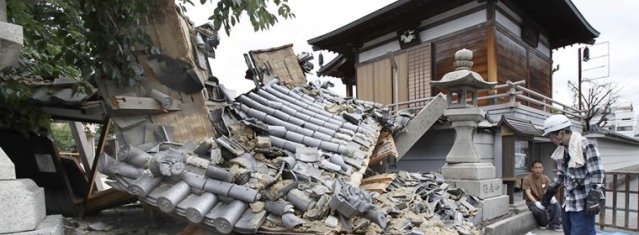News
Is Our Earth Telling Us Something?
Too many natural events to ignore.

Devastation in Japan (Source: Associated Press)
USPA NEWS -
The repeated earthquakes, wildfires, volcanic eruptions, fissures, and sink holes are trying to tell us something.
In the last month, the world has seen Hawaii´s Kilauea volcano erupt and it is still active. Guatemala´s Fuego volcano destroyed a town and killed entire families. Rain and sink holes devastated Florida land. There are also 21 uncontained large fires currently in the United States, in Washington State, California, Idaho, Utah, Colorado, Arizona, New Mexico, Texas, Oklahoma, and Alaska. Off the coast of Mexico, Tropical Storm Bud is threatening to strike the Baja shoreline. Last month, hurricane Alberto affected Florida and Cuba, with high winds and flooding, and left 23 people dead.
Fifty four significant earthquakes have occurred around the world so far this year. Significant events are determined by a combination of magnitude, number of “Did you feel it“ responses, and the Prompt Assessment of Global Earthquakes for Response (PAGER). PAGER provides shaking and loss estimates following significant earthquakes anywhere in the world within 30 minutes. Estimates include the number of people and names of cities exposed to each shaking intensity level and ranges of fatalities and economic losses. The lowest significant magnitude earthquake so far this year was on April 20th at a magnitude of 3.4, with the epicenter two kilometers east of Amherstburg, Canada. The highest magnitude to date was 7.9 on January 23rd and was located 280 kilometers southeast of Kodiak, Alaska. Now as the writing of this article, there has been a 6.1 magnitude earthquake in Japan, in the Osaka area.
If scientists are not already keeping track of all daily natural events, we need to see if there are any correlations between them. There is certainly too much going on to ignore the possibility. I will be tracking them and will have follow-ups.
Sources:
The Guardian
United States Department of Agriculture Forest Service
United States Geological Society
The Guardian
United States Department of Agriculture Forest Service
United States Geological Society
Liability for this article lies with the author, who also holds the copyright. Editorial content from USPA may be quoted on other websites as long as the quote comprises no more than 5% of the entire text, is marked as such and the source is named (via hyperlink).





